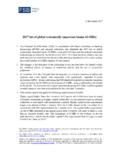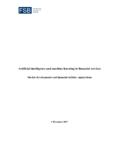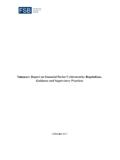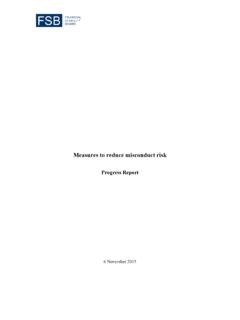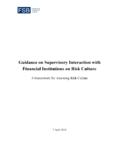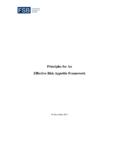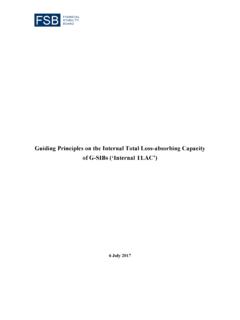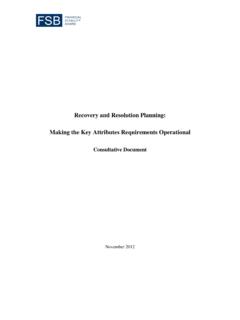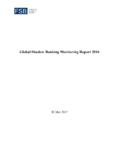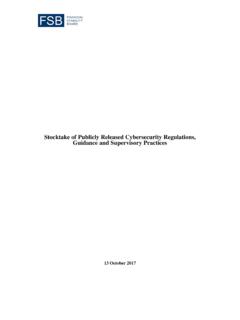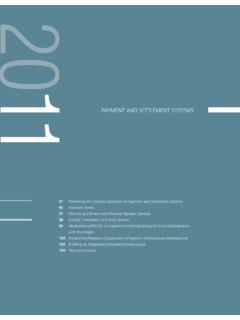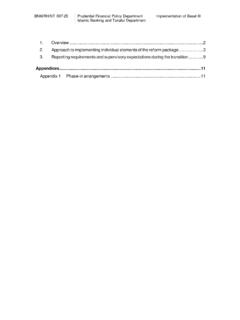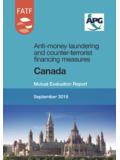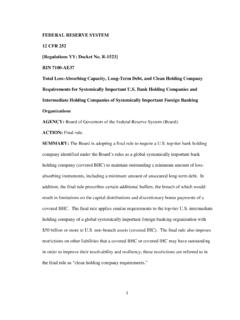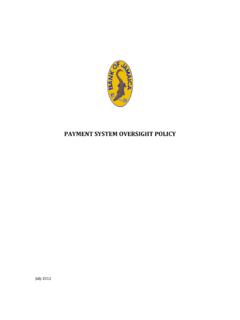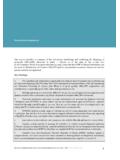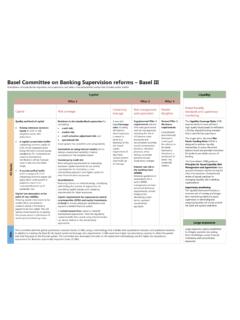Transcription of Reducing the moral hazard posed by systemically important ...
1 Reducing the moral hazard posed by systemically important financial institutions FSB Recommendations and Time Lines 20 October 2010 Table of Contents I. Overall policy framework to reduce moral hazard 1 II. Global SIFIs should have higher loss absorbency .. 2 Recommendations ..3 Processes and timeline for 3 III. SIFI resolution must be a viable option .. 3 Recommendations .. 4 Processes and timeline for 6 IV. Strengthening SIFI supervision .. 7 Recommendations .. 7 Processes and timeline for 8 V. Strengthening core financial infrastructures .. 8 Recommendations .. 8 Processes and timeline for 9 VI. Ensuring effective and consistent implementation of national policies for G-SIFIs.
2 9 Recommendations .. 9 Processes and timeline for 10 Annex: Summary of processes and timelines .. 11 ii 20 October 2010 Reducing the moral hazard posed by systemically important financial institutions FSB Recommendations and Time Lines I. Overall policy framework to reduce moral hazard risk This report recommends a policy framework for addressing the systemic and moral hazard risks associated with systemically important financial institutions (SIFIs) whose disorderly failure, because of their size, complexity and systemic interconnectedness, would cause significant disruption to the wider financial system and economic activity.
3 The report sets out recommendations for improving the authorities ability to resolve such institutions in an orderly manner, without exposing tax-payers to loss, while maintaining continuity of their vital economic functions. This will require changes to resolution regimes and tools at national levels, and legislative changes to enable resolution authorities to co-ordinate in cross-border resolutions. The report recommends that in particular financial institutions that are clearly systemic in a global context (G-SIFIs) should have higher loss-absorbency capacity than the minimum levels agreed in Basel III. These institutions must also be subject to more intensive co-ordinated supervision and resolution planning to reduce the probability and impact of their failure.
4 SIFIs vary in their structures and activities, and hence in the nature and degree of the risks they pose to the international financial system. Judgement is therefore needed both in determining the group of G-SIFIs to which this framework is to be applied, and for each of these institutions , the magnitude and combination of added loss absorbency measures that will deliver the necessary risk reduction. The FSB and relevant national authorities will exercise judgment on the former drawing on quantitative and qualitative indicators developed by international standard setting bodies and input from national authorities. With regard to the latter, the FSB will establish a process of peer review to assess whether the measures are being applied consistently on a country-by-country basis and commensurate with the risk posed on a G-SIFI-by-G-SIFI basis.
5 As experience is gained, the FSB will review how to extend the framework to cover a wider group of SIFIs, including financial market infrastructures, insurance companies and other non-bank financial institutions that are not part of a banking group structure. 1 Recommendations 1. All FSB jurisdictions should put in place a policy framework to reduce the risks and externalities associated with domestic and global systemically important financial institutions in their jurisdictions. 2. The policy framework for SIFIs should combine: - a resolution framework and other measures to ensure that all financial institutions can be resolved safely, quickly and without destabilising the financial system and exposing the taxpayer to the risk of loss; - a requirement that SIFIs and initially in particular global SIFIs (G-SIFIs) have higher loss absorbency capacity to reflect the greater risks that these institutions pose to the global financial system; - more intensive supervisory oversight for financial institutions which may pose systemic risk.
6 - robust core financial market infrastructures to reduce contagion risk from the failure of individual institutions and - other supplementary prudential and other requirements as determined by the national authorities. 3. Additionally, home jurisdictions for global SIFIs (G-SIFIs) should: - enable a rigorous co-ordinated assessment of the risks facing the G-SIFIs through international supervisory colleges; - make international recovery and resolution planning mandatory for G-SIFIs and negotiate institution-specific crisis cooperation agreements within cross-border crisis management groups (CMGs); - subject their G-SIFI policy measures to review by the proposed Peer Review Council. Processes for implementation 4. Resolution regimes and supervisory frameworks and policies will be the subject of FSB thematic or country peer review assessments for all member jurisdictions.
7 They will also be assessed as part of the IMF/World Bank FSAP. 5. FSB member countries that are home to G-SIFIs commit to participation in the G-SIFI Peer Review Council process. II. Global SIFIs should have higher loss absorbency Global SIFIs are institutions of such size, market importance, and global interconnectedness that their distress or failure would cause significant dislocation in the global financial system and adverse economic consequences across a range of countries. Standards for large global financial firms should be commensurate with the system-wide expected losses that their failure would produce. 2 Recommendations 6. G-SIFIs should have loss absorption capacity beyond the minimum agreed Basel III standards.
8 They should have a higher share of their balance sheets funded by capital and/or by other instruments which increase the resilience of the institution as a going concern. 7. Depending on national circumstances, this greater capacity could be drawn from a menu of viable alternatives and could be achieved by a combination of a capital surcharge, a quantitative requirement for contingent capital instruments and a share of debt instruments or other liabilities represented by bail-inable claims, which are capable of bearing loss at the point of non-viability, within resolution, thus enabling creditor recapitalisation and recovery while maintaining vital business functions. 8. In some circumstances, the FSB may recognise that further measures, including liquidity surcharges, tighter large exposure restrictions, levies, and structural measures could reduce the risks or externalities that a G-SIFI poses.
9 Processes and timeline for implementation 9. The Basel Committee is asked to complete by mid-2011 a study of the magnitude of additional loss absorbency that G-SIFIs should have, along with an assessment of the extent of going-concern loss absorbency which could be provided by the various proposed instruments. 10. The FSB and its members, will examine the legal, operational, market capacity and other issues bearing on the viability of contractual and statutory bail-in (see para 25 Section III on resolution below), and monitor the ongoing capacity of markets for these instruments. They will report on their findings by mid-2011. 11. Drawing on the above analyses, the FSB, in consultation with the BCBS, will recommend an additional degree of G-SIFI loss absorbency and the instruments by which these can be met by December 2011.
10 III. SIFI resolution must be a viable option Any effective approach to addressing the too big to fail problem needs to have effective resolution at its base. Such a regime must be able to prevent the systemic damage caused by a disorderly collapse without exposing the taxpayer to the risk of loss. To do this, the national regime must, as a basic starting point, provide the authorities with the tools to intervene safely and quickly to ensure the continued performance of the firm s essential financial and economic functions, including uninterrupted access of depositors to their funds wherever they are located, and to transfer and sell viable portions of the firm while apportioning losses, including to unsecured creditors, in a manner that is fair and predictable and so avoids panic or destabilization of financial markets.
